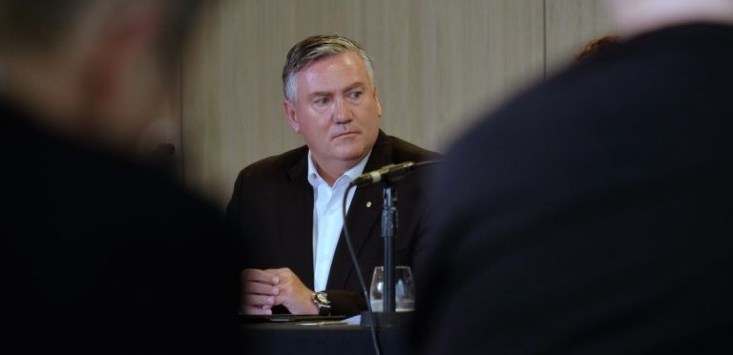
Former president of the Collingwood Football Club Eddie McGuire. Source: AAP/Luis Ascui.
The Collingwood Football Club report into incidents of racism and cultural safety — released to the club’s executives in December 2020 and to the public in February 2021 — is a doozy. A sad indictment on long unresolved issues left to fester away in hushed tones for way too long.
I encourage you to read it. It has a lot to say about our society, not just one football club.
Since the public release, the media has been vitriolic.
In fact, Eddie McGuire used that exact word in his resignation speech yesterday: “I’ve become a lightning rod for vitriol.”
He’s right. I’m not sure it’s helpful. I’m not going to add to it.
Eddie will be judged on three things now: his track record as a sports administrator of the most successful sports franchise in the country (across a whole range of factors on the field and off), his media career, and what he does next.
Especially for a kid from Broadmeadows, anyone would have to admit, he has soared high. I wish him well.
Instead, I’m going to take as constructive a path as I possibly can.
By virtue of a career in designing (among other complicated human systems) zero-tolerance approaches to bullying, harassment and discrimination, I have seen far too many bad cases, damming reports, and devastated people.
Instead of playing the man, I’m going to play the ball, and outline five lessons we can all learn from this.
It isn’t legal. It’s deeply human
For two decades, I’ve been working with people to understand it’s not a legal issue.
Sure, there is a legal baseline. The law says you cannot discriminate, vilify or harass someone based on their race. Or their gender. Or disability. Or sexual orientation. Or 13 other factors the law deems irrelevant to our ability to work.
But the ‘legal baseline’ is like the land on which you build a house. It’s important to have some land on which to build, but it won’t define your house.
When we talk about racism, misogyny, discrimination and harassment, we talk about deeply human pain and damage. Trauma. Often over multiple years, even generations.
Why anyone thinks you can solve that with a legal resolution or money never ceases to confound me.
I’m yet to meet a victim of racism or sexism or discrimination, who’s main objective wasn’t twofold: to stop the pain and to prevent it from happening again.
It’s very rarely about the money or winning the legal process. It’s about having their story told, having the pain recognised, and having an apology so they can hold their head high and know their pain and suffering was not of their making.
And it’s holding that history on record and not changing it.
The biggest crime in this space, which we see far too often, is rewriting history after it’s been set and resolved. Retelling it to suit corporate PR a few years down the track.
The lesson: don’t ever talk about these issues in the frame of a business, an organisation, a football club, or the impact on an executive’s career. It is always about the very human impact.
Beyond ‘empathy’ (which is pretty easy when you hear the stories) and out to support, care, concern and resolution for the person who has been traumatised. Nothing short of that is a solution.
Your process is judged by those who need it
When we review culture, one element is to look at the processes by which a person can raise a complaint, an issue or ask questions.
If culture is simply the ‘way we do things around here’, then how can people challenge the way things are around here?
Interestingly, whenever we look at the escalation or complaints processes, clients always want to quote the illustrious law firms and important IR experts who designed or have reviewed them. Instead, ask four simple questions.
- How many people have used it? If someone has used it, you at least have some data about how good it is. If no one has used it, it’s an untested hypothesis.
- What happened to them? When a process works, people come through the other side. Maybe a little bruised, but whole and able to go forward.
- The worst bully we’ve ever seen had 14 cases of exits, all within the designated process that people were told to follow. All faux ‘redundancies’ on the record, but all within the broken process. So the question is simple: ‘How many people participated in our escalation process and where are they now?’
- Would you recommend the process to resolve an issue? This is the final question we ask of people who’ve used the process.
If it works, and people feel listened to, heard, respected and seen, their issue properly dealt with, lessons have been learnt and they’ll recommend it.
It’s a myth that people want to hurt their company or employer.
In the first instance, they just want the pain stopped and prevented for anyone else. They want the process to work.
At Collingwood, Héritier Lumumba had participated in the process. More than once. It had failed. He wasn’t interested in revisiting that process.
You have to respect that that was a measure that the process hadn’t worked.
Accountability never goes away
The third lesson is there is no carpet thick enough or big enough, under which to sweep these issues. In no time at all, that bumpy carpet will feel like wall-to-wall eggshells.
You must resolve. Where there is wrong, there is accountability. There are also painful lessons that cannot be avoided.
The saddest thing is we always cast these stories as heroes and villains. That’s incredibly naïve. Even the best organisations and teams in the world will get it wrong.
I’m yet to meet the perfect executive or the perfect organisation. Every single large organisation gets it wrong sometimes.
It might be at the top of the board, across half the executive, or it might be a single leader, or a team gone rogue, but it happens.
The expectation should always be zero tolerance. The action should always be resolution and accountability. And that formula never goes away over time.
That accountability will lie there and wait until it’s taken. There is no resolution of trauma until there is acceptance, understanding and ultimately accountability.
You can be very, very good at lots of things, and no good at something important
This is the lesson from working with and coaching so many great CEOs and leaders. I’ve met and worked with excellence, but I’m yet to meet perfection.
And the best ones always acknowledge they’re still learning.
There was a beautiful quote from a Pies fan, under the handle FansCare: “Eddie is really good at lots of things, but not this.”
Maybe that sums it up.
Eddie is not good or bad, a hero or villain, but a human like the rest of us. He administered a great football club (and I say this reluctantly as a Blues fan). Picking it up from disarray and building it even better. Attracting great players and coaches, and no doubt even physiotherapists and psychologists. Instilling a winning mindset and engaging the largest fan base in the country.
But among all that, in 24 years, Eddie couldn’t get the culture around racism right, despite, in his words, continually trying.
But no leader is alone. The whole team failed to address it, and we do love to cast a villain in these stories.
Leadership requires much more than one person, because no one person has everything that’s needed.
Finally, a plea
The final lesson is a plea.
Do something.
Don’t just stand back and throw rocks.
Do something. Personally.
I’m always bemused by the term ‘bystander’. In life, most of us are in the audience, judging the performance of those on stage, not on the field with a role to play.
Here’s where I’m coming from. When you walk out the front door, into the workplace, into that meeting, into that conversation, into that social media post, you’re not an observer. You’re on the field. In the match. Even if you choose your impact on the game to be weak, you’re still a player.
Say what you will about Eddie and the Collingwood Football Club, but they did ask for the review, they did sit in front of the media and own it (albeit awkwardly), and they did take accountability (albeit through tears).
They (perhaps unintentionally) created a very public and perhaps long-overdue debate about racism and brought it to the top of every news story.
Rather than throwing stones, we each should pause and ask ourselves what are we personally doing to change the narrative of Australia, race and the future.
And this is where we land
Together, these five simple lessons give us the most constructive way we can look at systemic racism, bullying, discrimination and harassment.
- It isn’t just legal. Much more importantly, it’s deeply human.
- The processes need to work for the people who use them, not for the designers.
- Accountability lives on. Zero tolerance is the only option.
- No one is good at everything. We’re all learning.
- Do something. It is personal and every one of us can do more. If you think you’re in the stand, just as an observer, feel the grass. We’re on the field together.
Handpicked for you

Eddie McGuire’s response to Collingwood’s racism report is a lesson in how not to act in a crisis



COMMENTS
SmartCompany is committed to hosting lively discussions. Help us keep the conversation useful, interesting and welcoming. We aim to publish comments quickly in the interest of promoting robust conversation, but we’re a small team and we deploy filters to protect against legal risk. Occasionally your comment may be held up while it is being reviewed, but we’re working as fast as we can to keep the conversation rolling.
The SmartCompany comment section is members-only content. Please subscribe to leave a comment.
The SmartCompany comment section is members-only content. Please login to leave a comment.